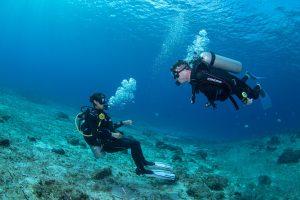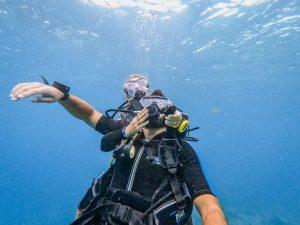If you have completed your open water and advance open water diving course and feel ready for what is coming next, the PADI Rescue Diver course is on the list.
A rescue scuba diving course is one of the most challenging courses to complete and teach. Despite its high difficulty level, most people who pass out this course say that choosing it was their best decision.
If you are still somewhere in the decision making and preparing yourself to take a scuba rescue course, let this post be your guide. In this post, we will look at questions like, what is the right time to take a scuba rescue course? Why should you complete it? And why choose the best instructor to get trained as the best rescuer?

Why should I go for PADI Rescue Diver course?
If you are a certified scuba diver in Cozumel, your first two courses got you basic skills to dive and make them advanced. However, a rescue course is more than getting advanced in your diving skills. It is about helping others. It starts with focusing and tuning in with fellow divers. You are going to explore your whole new side after passing the course.
The skills you will learn in this course will not stay with you in the water but will come in handy in another place as well. Ultimately, you become a confident diver and learn self-control.
While taking this course, you will develop a situational awareness and problem-solving attitude. Additionally, you are going to learn to respond to emergency situations and take the right course of action. Let us discuss the main reasons for taking this course:
- Improve your scuba diving skills and be a confident diver
- To be prepared for an emergency
- Save your diving buddies and rescue them to the surface.
- To qualify for the next level of certification, that is Divemaster.
- Last but not least, to have a skill only a few have.
Outline of your PADI Rescue Diver course:
Qualification:
To take a rescue diving course, you must be 12 years or older. Next, you must have first aid and CPR training before taking a scuba diving course. If you do not have CPR training, you can complete the Emergency first response course alongside your rescue diver course. At last, the most essential pre-requisite to joining the rescue course is to be a certified scuba diver and have an advanced open diver certification.
Classroom learning:
In the open water and advanced water diver course, you did theory lessons through classroom learning and e-learning. The rescue diver course also requires you to finish theory classes. The theory part of this course consists of psychological reactions to an emergency. You are going to read about specific rescue and first aid skills in the context of scuba diving, such as understanding decompression and pressure-related illness and injuries.
Open water dives and simulations:
Now comes the central part, and here you have to use your theoretical knowledge in your practical dive sessions. Initially, your instructor will teach you self-rescue techniques. You will be able to help and rescue other divers once you are safe yourself.
Next, you will learn underwater and surface signs and undergo a simulation exercise that will look just like a real-life rescue scenario. You will have to pass the drill using the props.
In the last part, you will face a missing diver situation and have to deal with it using your navigational skills. Learning these skills will be an extraordinary experience for you.
However, your drill is not over yet! You need to learn the most important skill, which is bringing an unresponsive diver to the surface. You need to get them to the surface and provide emergency rescue breaths to them. You need to practice each skill more and more, as muscle memory is the helper here.
Having the right coach or instructor by your side is vital before joining the PADI Rescue Diver course. You can find a coach by carrying your research and finding a reputed place for your training. A good instructor will never push away your concerns or queries. They will always be ready for open communication.
What is the right time to go for a rescue course?
This is a tricky question. Some people may feel super excited to take the course, and others might feel like spending time before taking the next step. So, it entirely depends on you. However, here are some of the tips divers have given on the forum scubaboard.com. Let us know them:
You can start when you are ready to add more task loading to your training: You know where you stand and how confident you feel underwater. So, introspect yourself and ask if you are ready to rescue or if you still feel underconfident. This will guide you to know the right time to opt for a rescue course.
Some divers have a benchmark of completing the decided number of dives before going for the rescue diver course. Most divers agree to have at least 40 to 60 dives under their belt before going to a rescue class.
You must also gather some control and skills before starting your scuba journey. So have to get control over buoyancy, trim, and propulsion techniques. If you are comfortable with these skills, you are probably ready.
In the end, it is essential to note that the PADI Rescue Diver course is about skills, confidence, and endurance. Your coaches will expect you to perform every task extraordinarily. The training will be challenging but fun.
Conclusion:
Scuba diving is an adventure, and the PADI Rescue Diver courses an even bigger. If, after reading this post, you feel like getting enrolled in a rescue diver course or any other course, Barefoot Diver Center in Cozumel provides all you need. They provide fun scuba diving sessions and also give certified and professional scuba diving courses. To enroll in any scuba diving courses and enjoy diving in the best locations in Cozumel, visit their website today!
Also Read : 9 Ways to Overcome Dive Anxiety in the Open Water Dive Course
